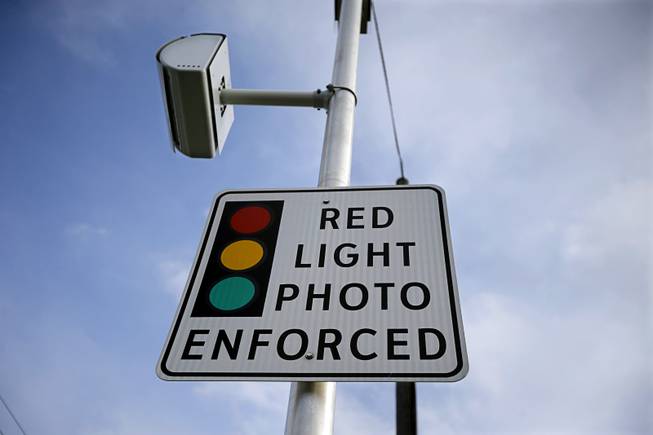
Mel Evans / AP
A red light photo enforcement sign is seen below a red light camera Tuesday, Dec. 16, 2014, in Lawrence Township, N.J.
Thursday, March 14, 2019 | 2 a.m.
If you play fast and loose with red lights, a bill in the Nevada Legislature might give you some pause.
Nevada may be the newest state to allow the use of cameras to help catch vehicles that run red lights, if a bill currently going through the committee process ultimately is signed into law.
Senate Bill 43 would allow local governments to install red light cameras under certain circumstances. Currently, Nevada law only allows traffic enforcement using cameras that are handheld or installed in a vehicle. So if you blow by a cop doing 30 over the speed limit, a dash cam footage is good for evidence.
Allowing red light cameras is a move that has received mixed responses in other states. Twenty-two states and the District of Columbia allow the devices in some fashion.
Whether these cameras help cut traffic accidents is up in the air. One paper claimed that the cameras did nothing to cut accidents, and a study done by the Chicago Tribune found that while crash rates had dropped in areas of Chicago, there wasn’t enough data to determine whether cameras should get the credit. The same study also found that some intersections in which cameras were installed saw an increase in crashes.
Governing magazine, a policy publication, wrote that the number of municipalities that allowed red light cameras dropped between 2012 and 2015, a change the publication attributed to citizen backlash to fines and a lack of evidence that cameras helped.
Let’s break down what the bill would do:
• A “governmental entity” would be able to install cameras at a problem stoplight. The entity would only be able to do so after it issued a finding that the spot had a high rate of traffic violations and resulting crashes, and that typical traffic law enforcement methods did not resolve.
• The entity would also be required to have a 30-day buffer period in which a public information campaign must be undertaken, install warning signs around the cameras and set up an appeal process for drivers caught by the cameras.
• Law enforcement would have to send the ticket to the vehicle’s registered owner within a month. If someone other than the vehicle's owner was driving, the owner can send an affidavit swearing the car was under the “care, custody and control” of another, or that it was stolen.
• Any punishment issued as a result of the bill would not go on the driver’s record, would not count as a moving violation and would have a minimum cost of $50. The bill lists no maximum fine, but if the citation was ignored outright the car owner would be fined an additional $100.
• All money received from citations in this bill would have to go toward paying for an automated traffic enforcement system, or paying for traffic safety programs.
In a presentation on the bill in mid-February before the Senate Committee on Growth and Infrastructure, Amy Davey, administrator of the Office of Traffic Safety with the Department of Public Safety, said using the monitoring cameras could cause an increase in rear-end collisions as drivers get used to them. Rear-end collisions, she said, are generally less severe than the T-bone crashes such cameras are meant to stop. She also brought up the cameras already marked for other uses on the highway and in public spaces.
“Cameras are already used to monitor highway traffic, alert first responders to issues, secure environments such as parking lots and building perimeters and placed on dashboards of vehicles, on toll roads and on livestream web cams in popular locations,” she said.
Metro Police lobbyist Chuck Callaway came out in support of the measure at the February meeting, citing the intersection of Sahara Avenue and Decatur Boulevard as one spot where the cameras could be used as a last resort when regular or, sometimes, irregular options have failed. Callaway said Metro had dressed an officer in a turkey suit on Thanksgiving and had them cross the street — it’s not really easily missed, he said.
“At that point, if the local government had the ability to put a red-light camera up there (we could) see if that helps deter some of this, but it would be kind of the last resort, so to speak,” he said.
Other groups, including Nevada Families for Freedom and the Nevada American Civil Liberties Union, spoke out against the bill. Holly Welborn, policy director of the Nevada ACLU, opposed the legislation on concerns it could be used by bad actors in law enforcement.
“We have a lot of questions about what these cameras are capable of capturing,” Welborn said. “We don’t know whether or not they are just capturing the license plate or if they’re capturing something else.”
The Senate committee has taken no action on the legislation, and the bill has not been scheduled for its next committee hearing.
